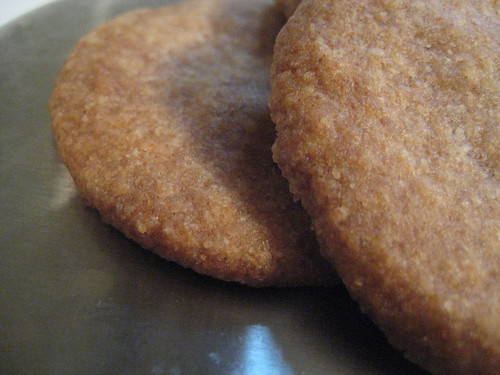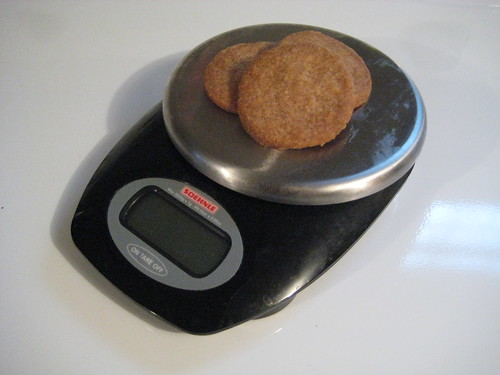
Friends at work know I love to cook, and most of my reading is about food - and they're gracious enough to grab books they think I'll like when the see them in the free books area. My office mate grabbed a galley (uncorrected version of a book) of the upcoming release Ratio: The Simple Codes Behind the Craft of Everyday Cooking
by Michael Ruhlman, and I'm in the midst of it right now.
The book's main thesis is that at their very essence, many foods are built on basic ratios of ingredients, and once you master these ratios, they free you to experiment. He talks about how learning a ratio is far superior to memorizing a recipe, because the ratio is the backbone of an infinite number of variations.
For example, one of the easiest ratios to remember is the 1-2-3 cookie recipe. 1 part sugar, 2 parts fat, and 3 parts flour (all by weight). So with a kitchen scale handy, you can measure out 2 oz of sugar and 4 oz of butter, cream them together, then blend in 6 oz of flour. The result is the essence of a cookie, which can be shaped into balls and pressed down onto a sheet pan, and baked at 350 degrees F for 15-20 minutes. Essentially, it's a shortbread cookie. Starting from there, you can use different sugars, different fats, swap out some of the flour for ground nuts, add other ingredients like chocolate or vanilla, a little salt... the possibilities are endless. But at the core of the cookie remains the 1-2-3 ratio.
I was feeling adventurous today, and after reading about the latest round of TGRWT (pairing smoked salmon and dark chocolate), I got the itch to play around in the kitchen. I didn't have dark chocolate or smoked salmon around (darn it), but an idea that came to me when I read the cookie chapter in Ratio seemed like a good way to play today.
Another great thing about the Ratio method is that you can downsize to very small quantities while you're playing around with flavors, and avoid wasting food. The degree of precision in weighing your ingredients ensures that you can always repeat any successes (and make note of any failures). So I pulled a small jar of bacon fat out of the fridge (saved from the bacon I got from
The result was a slightly sweet, golden brown cookie that smells of bacon but doesn't taste overwhelming like it, is crispy, but melts in your mouth thanks to the melting point of pork fat being below 98.6.
Perhaps the precision of measuring by weight appeals to me due to the years I spent in labs doing titrations and gathering precipitates in crucibles... but I love the idea of learning the 'DNA' of foods and then discovering the endless mutations I can create. Just call me Chef Moreau.
Now I just need to figure out the best use for these simple, tasty cookies. Any ideas for what to pair them with?







3 comments:
Bourbon ice cream or vanilla ice cream with bourbon sauce...or maybe maple syrup?
I think the best use would be in my belly! Sounds divine!
Definitely dark chocolate. Have you tried the Vosges chocolate bar with bacon in it? What about using hunks of that in your cookies?! Love the idea behind the Ratio book. I'll have to check it out when it hits the shelves.
Post a Comment